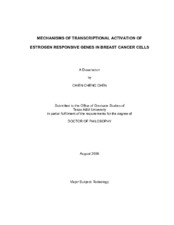| dc.description.abstract | Estrogen receptor (ER) acts as a ligand-activated transcription factor that regulates the expression of genes. The genomic mechanisms of ER action include ligand-induced dimerization of ER which binds estrogen responsive elements (EREs) in the promoters of target genes. There are also nongenomic mechanisms of ER action which are associated with membrane bound or cytosol ER-dependent activation of various protein-kinase cascades which also influence expression of target genes. Egr-1 is an immediate-early gene induced by 17β-estradiol (E2) in the rodent uterus and breast cancer cells. Deletion analysis of the Egr-1 promoter identified a minimal E2-responsive region that contained serum response element (SRE3) which bound Elk-1 and serum response factor (SRF) in gel mobility shift assays. Hormone-responsiveness of Egr-1 in MCF-7 cells was specifically inhibited by PD98059, a MAPKK inhibitor, but not by LY294002, an inhibitor of PI3-K. These results contrasted with the hormone-dependent activation of the SRE in the c-fos promoter, which was inhibited by both PD98059 and LY294002, suggesting that Egr-1, like c-fos, is activated through non-genomic pathways of estrogen action but through activation of different kinases. COUP-TFs are orphan nuclear receptors expressed in a variety of tissues where they regulate biological functions and organogenesis. In this study, we investigated coactivation of ERα by COUP-TF1 in cell lines transiently cotransfected with the pERE3 construct. COUP-TFI coactivated ERα-mediated transactivation, but unlike many other coactivators, COUP-TFI also enhanced transactivation of ERα when cells were cotransfected with the TAF1-ERα mutant or the 19c-ERα mutant. These data indicate that helix 12 of ERα is not required for coactivation by COUP-TFI when AF-1 of ERα is intact. However, when the AF-1 of ERα is deleted, the intact AF-2 function is required for coactivation by COUP-TFI. Analysis of multiple COUP-TFI deletion mutants showed that the DNA-binding domain and C-terminal region of COUP-TFI were important for coactivation of ERα. Point mutations of the DNA-binding domain of COUP-TFI resulted in loss of interactions with ERα, suggesting that the DNA-binding domain of COUP-TFI is important for its coactivation activity facilitating interactions with ERα. These results demonstrate that COUP-TFI coactivated ERα through a non-classical LXXLL-independent pathway. | en |


